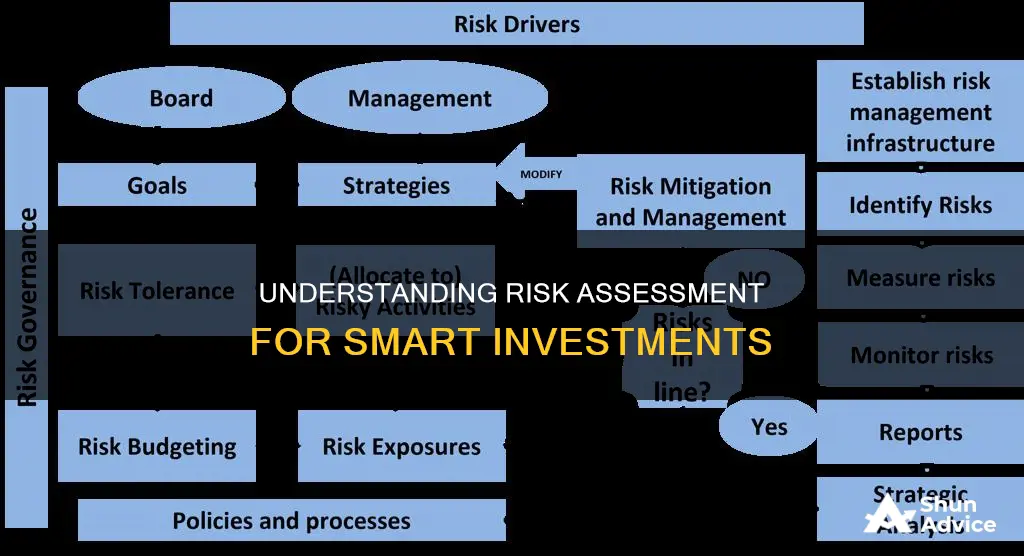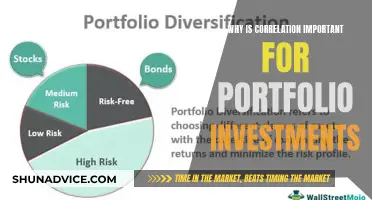
Risk assessment is a crucial aspect of investing, helping investors make informed decisions by evaluating the potential downsides of an investment opportunity. It involves analysing the likelihood of adverse events impacting an investment and determining the level of risk an investor is willing to accept. While numbers and statistics are essential tools in risk assessment, they don't tell the whole story, and it's crucial to consider other factors such as market volatility, investment diversification, and qualitative analysis. By understanding and effectively managing risk, investors can make more informed decisions, aligning their portfolios with their risk tolerance and financial goals.
What You'll Learn

Risk tolerance: How much risk you can emotionally handle
Risk tolerance is a crucial aspect of investment risk assessment, referring to an individual's ability to emotionally and psychologically accept and deal with the uncertainty and volatility associated with financial risk-taking. It is about one's comfort level with risk rather than their financial capacity to absorb losses.
Risk tolerance is subjective and varies from person to person, influenced by factors such as personality, past experiences, need for stability, age, gender, and income. Some individuals are comfortable with taking on risk and view volatility as an exciting opportunity, while others are more anxious about losing money and prefer to preserve their capital, even if it means potentially lower returns.
To determine your risk tolerance, consider the following:
- Get clear on your financial goals: Ask yourself what you're saving for, when you need to withdraw funds, and how long you'll need the money to last. Generally, a longer timeline allows for taking on more risk since there is more time to recover from potential losses.
- Think about your comfort with guaranteed results vs. chance outcomes: Consider whether you prefer a guaranteed outcome or are willing to take the risk of potentially losing it all for the chance of larger gains.
- Reflect on your emotional reactions to risk: How do you feel when you see numbers in the red or hear dismal market news? Are you comfortable with the idea of riding out heavy losses, or does it stress you out?
Understanding your risk tolerance is essential for making informed investment decisions. It helps you choose the right stocks, bonds, funds, and ETFs that align with your financial goals and emotional well-being. It also guides the construction of a balanced portfolio that respects your emotional comfort and financial reality, allowing you to pursue your financial objectives while maintaining peace of mind.
Understanding ERISA 316: Investment Manager's Role and Responsibilities
You may want to see also

Risk capacity: How much risk you can financially manage
Risk capacity is an objective measure of how much risk you can take on based on your financial situation and how much time you have to invest. It is different from risk tolerance, which is about your emotional response to risk and your comfort with losses. While risk tolerance is based on feelings, risk capacity is based on your current circumstances and financial goals.
There are several factors that determine your risk capacity:
- Time horizon: The amount of time you plan to stay invested affects your risk capacity. A longer time horizon means a higher risk capacity, as your investments have more time to recover from any dips. For example, if you are investing for retirement at 65, your money can remain in the market for longer and has a greater chance of riding out severe dips. On the other hand, if you are investing for a goal you want to accomplish in a shorter time frame, such as in the next five years, your risk capacity is lower as you have less time to recoup any losses.
- Financial situation: Your income, expenses, and disposable income can impact your risk capacity. If you have higher expenses and less disposable income, you may have a lower risk capacity as your money might be needed for other priorities, such as building an emergency fund. In contrast, someone with lower expenses or more disposable income may have a higher risk capacity as they can take on riskier investments while still having a safety net of cash.
- Personal circumstances: If you have family members or dependents that you care for, you may want to make safer investments to ensure that your money isn't subject to high volatility. This can give you a higher likelihood of being able to withdraw from a comfortable balance if needed.
- Size of investment portfolio: The size of your investment portfolio relative to future additions and withdrawals can impact your risk capacity. If you have a large portfolio and can save additional money from other income sources, you may have a higher risk capacity. Conversely, if your portfolio is small and you need to make withdrawals soon, your risk capacity is lower.
- Income sources: The amount and reliability of income from sources other than your investment portfolio can also affect your risk capacity. If you have a steady and growing source of income, such as a salary, you may have a higher risk capacity as you can potentially offset any investment losses with your income.
It's important to note that risk capacity and risk tolerance are not the same, and you may have a high risk capacity but a low risk tolerance, or vice versa. Robo-advisors and financial professionals can help you assess your risk capacity and tolerance and guide you toward the right investments.
Understanding Investment Strategies: Model Portfolios Explained
You may want to see also

Time horizon: How long you have to invest
When assessing the risk of an investment, one of the most important concepts to understand is the time horizon, or how long you have to invest. This is the period of time you expect to hold an investment until you need the money back. Time horizons are dictated by investment goals and strategies, and they can be short-term, medium-term, or long-term.
Short-term investment horizons refer to investments that are expected to last for fewer than five years. These are suitable for investors who are approaching retirement or who may need a large sum of cash in the near future. Money market funds, savings accounts, certificates of deposit, and short-term bonds are good choices for short-term investments since they can easily be liquidated for cash.
Medium-term investments are those that are expected to be held for three to ten years. This is common for people saving for college, marriage, or a first home. Medium-term investment strategies tend to balance between high- and low-risk assets, so a mix of stocks and bonds is a suitable way to protect your wealth without losing value to inflation.
Long-term investment horizons are for investments that are expected to be held for ten or more years, often for retirement savings. Long-term investors are typically willing to take greater risks in exchange for greater rewards. With a longer time horizon, you can afford to take bigger risks as you have more time to recover from any losses.
The time horizon will help determine what types of investments are most suitable for your goals. For example, if you are saving for a vacation in three years, you might invest in a mutual fund, which will provide a safe harbour for your money and help it grow. On the other hand, if you are investing for retirement, you can afford to be more aggressive and take on more risk, such as investing in stocks.
It's important to note that the time horizon is not set in stone and can change as your goals and circumstances change. For instance, if you are saving for a down payment on a house in two years, your risk ability is much lower, and you may want to stick with low-risk bonds and cash to avoid any sharp swings in stocks. However, if your goal is decades away, you might want to invest in stocks to beat inflation and take advantage of the highest rate of return.
Investing in 5G: Strategies for Profitable Opportunities
You may want to see also

Bankroll: How much money you can afford to lose
When assessing how much money you can afford to lose, it's important to consider your risk tolerance and risk capacity. Risk tolerance refers to how much risk you are emotionally able to handle, while risk capacity is about how much risk you can afford to take on financially.
Your risk tolerance is influenced by your personality, beliefs, and investment experience. It's important to understand how you might respond to market volatility and drastic swings. Are you comfortable with the possibility of significant losses? How will you react if you see your investments drop in value? If you have a low-risk tolerance, you may want to stick with conservative investments such as treasury bonds, which offer lower risk but also lower returns.
On the other hand, risk capacity is determined by your financial situation, age, and time horizon. Factors such as your liquidity needs, time horizon, and the importance of the investment goal play a crucial role in assessing your risk capacity. For example, if you are saving for a down payment on a house in the next year, you have a shorter time horizon and a lower risk capacity. In this case, opting for more conservative, low-risk investments is advisable, even if you have a higher risk tolerance.
It's also essential to consider the potential impact of losses on your financial goals. For instance, if you are saving for your child's education or nearing retirement, a more conservative or moderate approach may be necessary to lower the risk of not achieving your goals.
By understanding both your risk tolerance and risk capacity, you can make informed investment decisions that align with your financial situation and comfort level. It's crucial to regularly review and reassess your risk tolerance and capacity, especially when experiencing significant life changes or shifts in your financial circumstances.
Microservices in Investment Portfolio Management: Strategies and Benefits
You may want to see also

Risk-reward: The trade-off between risk and potential returns
The trade-off between risk and potential returns is a fundamental concept in investing. This relationship, often referred to as risk-reward, suggests that the potential returns from an investment are directly related to the level of risk associated with it. In other words, higher-risk investments offer the possibility of higher returns, while lower-risk investments tend to provide more moderate profits.
When assessing the trade-off between risk and potential returns, it is essential to consider two key factors: risk tolerance and risk capacity. Risk tolerance refers to an individual's emotional capacity to handle investment risk and is influenced by factors such as personality and beliefs. On the other hand, risk capacity is the financial ability to take on risk and is determined by factors such as financial situation and time horizon.
Understanding one's risk tolerance is crucial in determining the appropriate level of risk for an investment strategy. Individuals with a higher risk tolerance may be more comfortable with volatile investments and potential losses, seeking opportunities for higher returns. Conversely, those with a lower risk tolerance may prefer more conservative investments that prioritise capital preservation over potential gains.
Risk capacity, on the other hand, is influenced by factors such as liquidity needs, time horizon, and the importance of the investment goal. For example, an individual saving for retirement may have a longer time horizon and a higher risk capacity, as they can withstand potential short-term losses in pursuit of higher returns over the long term. Conversely, an individual saving for a down payment on a house in the near future would have a lower risk capacity, as they cannot afford significant losses and need more stable investments.
The investment risk pyramid is a useful framework for visualising the trade-off between risk and potential returns. The pyramid consists of three tiers, with low-risk assets like cash and government bonds at the base, medium-risk assets like corporate bonds and blue-chip stocks in the middle, and high-risk assets like growth stocks at the top. This structure helps investors diversify their portfolios according to their risk tolerance and capacity, ensuring a balance between risk and potential returns.
In conclusion, the trade-off between risk and potential returns is a critical aspect of investment decision-making. By understanding their risk tolerance and risk capacity, investors can make more informed choices about the level of risk they are comfortable with and the potential returns they can expect. The investment risk pyramid provides a useful tool for allocating assets based on risk profiles, helping investors achieve their financial goals while managing risk effectively.
Roth Accounts: Savings or Investment?
You may want to see also
Frequently asked questions
Risk in investment refers to the possibility of an investment performing below expectations. All investments carry some level of risk, from losing money when the price of an investment changes to a loss of purchasing power due to inflation.
Risk tolerance is how much risk you are willing to bear when investing. It is based on your beliefs, personality, and investment experience. To determine your risk tolerance, you must understand how you would respond to drastic swings in the market and your ability to stick to a plan during challenging periods.
Risk tolerance refers to your emotional capacity for risk, while risk capacity is your financial ability to take on risk. Risk capacity is based on factors such as your financial situation, age, and time available for investing.
A higher risk tolerance means you may opt for investments with faster growth and higher potential returns, even if it means your holdings may lose value at times. A lower risk tolerance means you would choose investments that aim to protect your capital, even if it means potentially lower returns.







